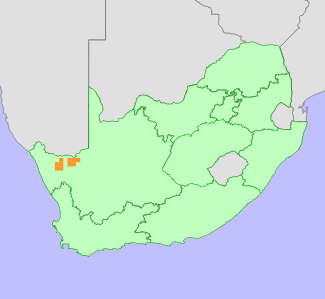|
Scientific Name | Conophytum calculus (A.Berger) N.E.Br. subsp. vanzylii (Lavis) S.A.Hammer |
Higher Classification | Dicotyledons |
Family | AIZOACEAE |
Synonyms | Conophytum breve N.E.Br. var. vanzylii (Lavis) Rawé, Conophytum namiesicum L.Bolus, Conophytum vanzylii Lavis |
National Status |
Status and Criteria | Critically Endangered A4d |
Assessment Date | 2021/11/16 |
Assessor(s) | A.J. Young, P.G. Desmet, I. Ebrahim, D. Guo, A. Harrower, L. Jabar, L. Knoetze, C. Rodgerson, P.C.V. Van Wyk & N.N. Mhlongo |
Justification | This succulent is endemic to the Northern Cape province of South Africa with an extent of occurrence (EOO) of 4,243 km2 and area of occupancy (AOO) of 112 km2. The population is experiencing decline due to the illegal ornamental succulent plant trade, with collection likely to increase as there has been a dramatic increase in the number of species and volume of plants targeted since 2019. The continued threat of illegal collection for this sought after and slow-growing succulent is therefore regarded as very high. The scattered distribution of the plants across the landscape may slow the rate at which illegal collection impacts this subspecies. Climate change is also impacting the population although there is uncertainty of the response given the expected resilience of this taxon. Mining and livestock grazing also present localised threats and a decline of 80% of the population is likely within the next three generations (90 years). It therefore qualifies as Critically Endangered under criterion A4. |
Distribution |
Endemism | South African endemic |
Provincial distribution | Northern Cape |
Range | This taxon is endemic to the Northern Cape province of South Africa. |
Habitat and Ecology |
Major system | Terrestrial |
Major habitats | Aggeneys Gravel Vygieveld, Bushmanland Inselberg Shrubland, Namaqualand Klipkoppe Shrubland |
Description | This taxon is found in the Nama-Karoo biome. It is located in the Bushmanland and West Griqualand bioregion. The plants are found on areas covered with quartz stones and pebbles. The plants experience winter rainfall but also experience light summer rainfall. This taxon has a generation length of 30 years. It is expected to be sensitive to the impacts of climate change as it does not disperse and while adapted to arid conditions, is dependent on limited seasonal rainfall. Species in the genus are sensitive to long periods of drought. Drought related mortality has been observed for other closely related taxa within the genus. |
Threats |
| This taxon is currently threatened by illegal collection for the succulent trade. This is a slow growing plant that has become particularly sought after by collectors. Whilst plants are present as scattered plants, sometimes forming small colonies in numerous subpopulations scattered across a broad area of Bushmanland on remote inselbergs the plants at individual sites are easily targeted. Illegal collection is likely to increase in future as there has been a dramatic increase in the number of species and volume of plants targeted since 2019 and a population reduction of 80% is likely within three generations.
Anthropogenic climate change is a long-term threat to this succulent. Climate models for the likely emission scenarios where emissions stay at present day levels (RCP 2.6) (Hausfather and Peters 2020) and worst case scenarios where emissions continue to increase during the 21st century (RCP 8.5) indicate that there will be a loss of suitable bioclimatic envelope of between 32% and 81% by 2080 for this taxon. However, as this taxon possesses certain morphological traits likely to afford resilience to xerophytic conditions and is found across several vegetation units it is expected to have a level of resilience to climate change and the expected population loss is reduced by 20% to 12%. Species in this genus have limited dispersal ability and migration to suitable habitats elsewhere is regarded as highly unlikely.
Mining has degraded some of the suitable habitat for this species. Grazing and trampling by livestock is also a localised threat. |
Population |
There is no formal estimate of population size but it is estimated to have in excess of 10,000 mature individuals. The population is declining as a result of illegal collection of wild specimens to supply the ornamental succulent plant trade.
|
Population trend | Decreasing |
Assessment History |
Taxon assessed |
Status and Criteria |
Citation/Red List version | | Conophytum calculus (A.Berger) N.E.Br. subsp. vanzylii (Lavis) S.A.Hammer | VU A4cd | 2020.1 | | Conophytum calculus (A.Berger) N.E.Br. subsp. vanzylii (Lavis) S.A.Hammer | Least Concern | Raimondo et al. (2009) | |
Bibliography |
Hammer, S. 2002. Dumpling and his wife: New view of the genus Conophytum. EAE Creative Colour, Norwich.
Hammer, S.A. 1993. The genus Conophytum: A conograph. Succulent Plant Publications, Pretoria.
Hausfather, Z. and Peters, G.P. 2020. Emissions - the 'business as usual' story is misleading. Nature 577(618-620).
|
Citation |
| Young, A.J., Desmet, P.G., Ebrahim, I., Guo, D., Harrower, A., Jabar, L., Knoetze, L., Rodgerson, C., Van Wyk, P.C.V. & Mhlongo, N.N. 2021. Conophytum calculus (A.Berger) N.E.Br. subsp. vanzylii (Lavis) S.A.Hammer. National Assessment: Red List of South African Plants version . Accessed on 2025/08/25 |
 Comment on this assessment
Comment on this assessment


